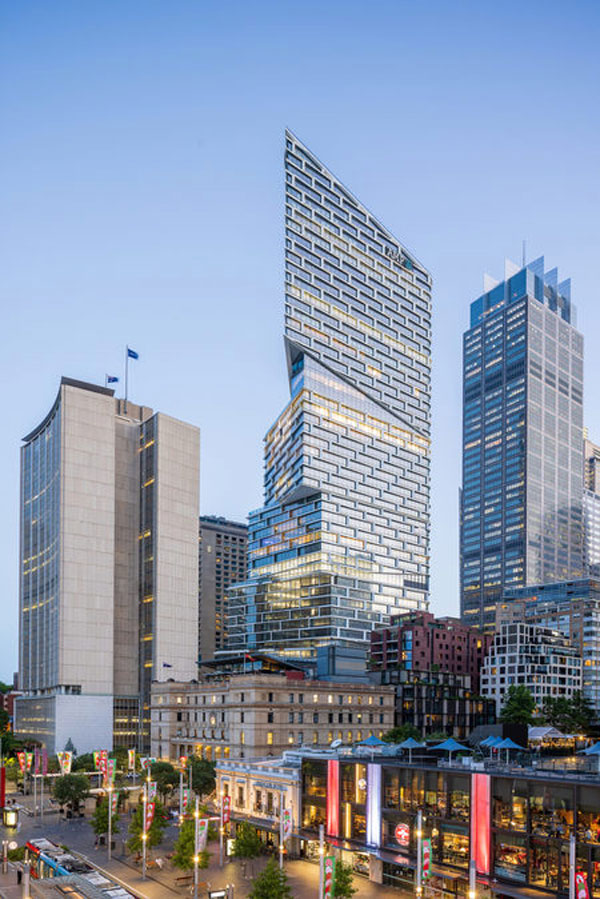
As ironic as it might sound, a 49-storey office tower originally built in the mid-1970s was named World Building of the Year at the World Architecture Festival’s 2022 Awards in Lisbon.
Located on the waterfront of Sydney, Aus. at Circular Quay, the AMP Centre was expected to reach the end of its useful life in 2013. Instead, the recently completed and renamed Quay Quarter Tower (QQT) today stands as the most comprehensive transformation project ever completed, and a striking demonstration of how older buildings can find new life and purpose by avoiding demolition.
Building owner AMP Capital, one of Australia’s largest retail and corporate pension providers, sought a commercial tower that was both more energy-efficient and elegant. It could have simply demolished the AMP Centre and started again. After all, that’s what so often happens when the inefficiencies, esthetics and operational demands of older buildings are surpassed by modern expectations.
However, AMP chose to do something completely different. Wanting to minimize the environmental impact of a full demolition, AMP opened a global design competition, challenging architects to create a new building without removing the existing one.

Danish architectural firm 3XN was chosen as the winner and lead designer in 2014. It teamed up with Arup, a global collective of designers, engineering and sustainability consultants based in the U.K., and Australian architectural firm BVN. A new tower was created utilizing 95 per cent of the AMP Centre’s original core and two-thirds of its beams and columns. When blended with new sections, floor space and the number of potential occupants were doubled.
What is notable about the new QQT goes beyond what was created to what was preserved.
By repurposing so much of the original building, an estimated 12,000 tons of embodied carbon were saved, said to be the equivalent C02 produced by 35,000 inter-city flights between Sydney and Melbourne. AMP also estimates that US$102 million and 12 months of construction time was saved.
Incorporating so much original in-place structure required a comprehensive approach referred to as “upcycling.”
Serious engineering considerations were required, including determining the degree to which the original tower had shrunk from its original drawings over time under its own weight. This affected the alignment of new building elements with the old.
Sensors installed to track any structural movements were fed into a 3D digital twin of the tower to ensure full compatibility. Before old and new elements were fully connected, a 13-foot gap between old and new structures allowed new concrete to settle.
The new QQT is exactly what AMP had hoped for: an eye-catching design of five stacked sections connected by atriums twisting skyward, with rooftop terraces and retail space. Full occupancy is expected by mid-2023, with AMP itself as the lead tenant.
Former president of the American Institute of Architects, Carl Elefante, has been quoted saying, “The greenest building is the one that already exists.”
This summarizes the challenge for the commercial construction industry and project investors going forward.
It is estimated nearly 1,000 office properties built between 1953 and 1980, and taller than 338 feet, still stand today. Some have been retrofitted to a degree. However, others facing full demolition could result in C02 emissions measured in the millions of tons. Upcycling along the lines of AMP’s QQT project demonstrates an alternative for owners and designers.
“This award emphasizes the importance of daring to reimagine how we approach the future of our built environment,” 3XN Founding Partner Kim Nielsen said in reference to QQT’s World Building of the Year recognition.
“Perhaps we can imagine skylines and towers across the world being transformed in the years to come. Quay Quarter Tower is a project about transformation: urban, social, and environmental. Instead of demolishing a building that no longer worked for its users, we have prolonged its life and given it new form and character – with its further transformation in mind.”
John Bleasby is a Coldwater, Ont.-based freelance writer. Send comments and Inside Innovation column ideas to [email protected].